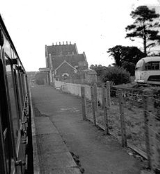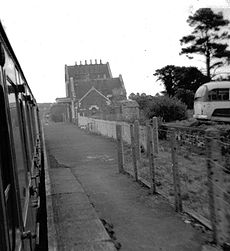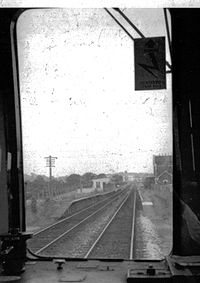
Bow, Devon
Encyclopedia
Bow is a village and civil parish
in the Mid Devon
district of Devon
, England
, about 8 miles west of Crediton
. According to the 2001 census it had a population of 1,093. There is an adjoining hamlet of Nymet Tracey which shares a church with Bow and much common history.
west of the village. Its 19 post holes were discovered by aerial photography in 1984. It is believed to have been the cultic centre for a large area of surrounding countryside. The name Nymet means "Sacred Grove" in Celtic and is associated in Roman terms with the Druid
s. The word Nymet is preserved in many surrounding place names (e.g. Nymet Barton, Nymet Rowland
, Broad Nymet). The River Yeo
, which used to be called the Nymet, flows through the "arched bridge" at the bottom of the village
The main settlement was originally at Nymet Tracey, a mile south of Bow's present location. Nymet Tracey had parliamentary representation in late Anglo-Saxon
times, from 940 onwards and is mentioned in the Domesday Book
of 1086.
 The name Tracey comes from the 'de Tracey' family - from Tracy
The name Tracey comes from the 'de Tracey' family - from Tracy
near Bayeux
- who settled in the area after the Norman Conquest of 1066. The face of a de Tracey knight is carved over the south entrance to the church at Nymet Tracey, St Bartholomew's (formerly called St Martin's
). The knight may be a representation of William de Tracy
, who founded the church in penance for the murder of Thomas Becket
. However, there is no independent evidence for this, beyond local tradition.
In 1258-59 Henry de Tracey was granted charters for a weekly market and a 3-day annual fair starting on St Martin's Day. The market was held on the main Crediton
to Okehampton
road (now the A3072), and so Bow was born. The A3072 road is almost certainly a Roman road
, although not the first in the area. The first was south of the village, and runs from the Roman fort at North Tawton
to Isca
(Exeter
).
Charles I
stayed one night in Bow during the Civil War
when he was chasing the Earl of Essex
into Cornwall
.
Bow, due to its location, failed to attract enough trade to justify its status as a town and remained a de facto street village or one of Devon's many "failed towns". The market ceased in 1792. Nymet Tracey was effectively absorbed into Bow following two fires which destroyed Nymet Tracey (then about 60-80 cottages) in 1833 and 1835, after which the bulk of the populace of Nymet Tracey proper decamped to Bow. Nymet Tracey's church, St Martin's at the time, continued to serve Bow. The influx of people did not halt its decline and by 1850 Bow/Nymet Tracey was described as a "small, decayed market town"; the St Martin's Day fair ceased c.1900 and around this time the church was rededicated from St Martin to Saint Bartholomew.
In the late 19th and early 20th centuries Bow was spiritually divided between the Church of England
, the Congregationalists and the Plymouth Brethren
.
and a Gospel Hall (Open Brethren
). Its railway station
, like so many others, fell victim to the Beeching Axe
in the early 1970s.
In recent years Bow has expanded considerably to the south. Bow boasts a general store, a large garden centre (Bow Aquatic Centre) and one public house. It has a doctor's surgery and a community policeman.

Civil parish
In England, a civil parish is a territorial designation and, where they are found, the lowest tier of local government below districts and counties...
in the Mid Devon
Mid Devon
Mid Devon is a local government district in Devon, England. Its council is based in Tiverton.The district was formed under the Local Government Act 1972, on 1 April 1974 by the merger of the borough of Tiverton and Crediton urban district together with Tiverton Rural District, and Crediton Rural...
district of Devon
Devon
Devon is a large county in southwestern England. The county is sometimes referred to as Devonshire, although the term is rarely used inside the county itself as the county has never been officially "shired", it often indicates a traditional or historical context.The county shares borders with...
, England
England
England is a country that is part of the United Kingdom. It shares land borders with Scotland to the north and Wales to the west; the Irish Sea is to the north west, the Celtic Sea to the south west, with the North Sea to the east and the English Channel to the south separating it from continental...
, about 8 miles west of Crediton
Crediton
Crediton is a town and civil parish in the Mid Devon district of Devon in England. It stands on the A377 Exeter to Barnstaple road at the junction with the A3072 road to Tiverton, about north west of Exeter. It has a population of 6,837...
. According to the 2001 census it had a population of 1,093. There is an adjoining hamlet of Nymet Tracey which shares a church with Bow and much common history.
History
There is a 3rd millennium BC woodhengeWoodhenge
Woodhenge is a Neolithic Class I henge and timber circle monument located in the Stonehenge World Heritage Site in Wiltshire, England. It is north-east of Stonehenge in the parish of Durrington, just north of Amesbury.-Discovery:...
west of the village. Its 19 post holes were discovered by aerial photography in 1984. It is believed to have been the cultic centre for a large area of surrounding countryside. The name Nymet means "Sacred Grove" in Celtic and is associated in Roman terms with the Druid
Druid
A druid was a member of the priestly class in Britain, Ireland, and Gaul, and possibly other parts of Celtic western Europe, during the Iron Age....
s. The word Nymet is preserved in many surrounding place names (e.g. Nymet Barton, Nymet Rowland
Nymet Rowland
Nymet Rowland is a small village, and parish of the same name, in central Devon, England, north of Dartmoor. It takes part of its name from "Nymet", the old name for the nearby River Yeo. It is located just to the west of Lapford and south of Nymet Bridge, within the Mid Devon local authority area....
, Broad Nymet). The River Yeo
River Yeo (Lapford)
The River Yeo is a tributary of the River Taw in Devon, England, sometimes known as the Lapford Yeo from the village of Lapford. It is one of several rivers of the same name in Devon, including another tributary of the Taw, the Barnstaple Yeo...
, which used to be called the Nymet, flows through the "arched bridge" at the bottom of the village
The main settlement was originally at Nymet Tracey, a mile south of Bow's present location. Nymet Tracey had parliamentary representation in late Anglo-Saxon
History of Anglo-Saxon England
Anglo-Saxon England refers to the period of the history of that part of Britain, that became known as England, lasting from the end of Roman occupation and establishment of Anglo-Saxon kingdoms in the 5th century until the Norman conquest of England in 1066 by William the Conqueror...
times, from 940 onwards and is mentioned in the Domesday Book
Domesday Book
Domesday Book , now held at The National Archives, Kew, Richmond upon Thames in South West London, is the record of the great survey of much of England and parts of Wales completed in 1086...
of 1086.

Tracy-sur-Mer
Tracy-sur-Mer is a commune in the Calvados department in the Basse-Normandie region in northwestern France.-History:The city was part of the west flank of the British 50th Infantry Division during the first days of the D-day invasion, in close proximity to the port of Arromanches-les-Bains, also...
near Bayeux
Bayeux
Bayeux is a commune in the Calvados department in Normandy in northwestern France.Bayeux is the home of the Bayeux Tapestry, which depicts the events leading up to the Norman conquest of England.-Administration:Bayeux is a sub-prefecture of Calvados...
- who settled in the area after the Norman Conquest of 1066. The face of a de Tracey knight is carved over the south entrance to the church at Nymet Tracey, St Bartholomew's (formerly called St Martin's
Martin of Tours
Martin of Tours was a Bishop of Tours whose shrine became a famous stopping-point for pilgrims on the road to Santiago de Compostela. Around his name much legendary material accrued, and he has become one of the most familiar and recognizable Christian saints...
). The knight may be a representation of William de Tracy
William de Tracy
Sir William de Tracy, Knt., was Lord of the Manor of Toddington, Gloucestershire, feudal Baron of Bradninch, near Exeter, and Lord of Moretonhampstead, Devon...
, who founded the church in penance for the murder of Thomas Becket
Thomas Becket
Thomas Becket was Archbishop of Canterbury from 1162 until his murder in 1170. He is venerated as a saint and martyr by both the Roman Catholic Church and the Anglican Communion...
. However, there is no independent evidence for this, beyond local tradition.
In 1258-59 Henry de Tracey was granted charters for a weekly market and a 3-day annual fair starting on St Martin's Day. The market was held on the main Crediton
Crediton
Crediton is a town and civil parish in the Mid Devon district of Devon in England. It stands on the A377 Exeter to Barnstaple road at the junction with the A3072 road to Tiverton, about north west of Exeter. It has a population of 6,837...
to Okehampton
Okehampton
Okehampton is a town and civil parish in West Devon in the English county of Devon. It is situated at the northern edge of Dartmoor, and has an estimated population of 7,155.-History:...
road (now the A3072), and so Bow was born. The A3072 road is almost certainly a Roman road
Roman road
The Roman roads were a vital part of the development of the Roman state, from about 500 BC through the expansion during the Roman Republic and the Roman Empire. Roman roads enabled the Romans to move armies and trade goods and to communicate. The Roman road system spanned more than 400,000 km...
, although not the first in the area. The first was south of the village, and runs from the Roman fort at North Tawton
North Tawton
North Tawton is a small town in Devon, England, situated on the river Taw.-History:The Romans crossed the River Taw at what is now Newland Mill, a little outside the present town, and established a succession of military camps there over the years...
to Isca
Isca Dumnoniorum
Isca Dumnoniorum was a town in the Roman province of Britannia and the capital of Dumnonia in the sub-Roman period. Today it is known as Exeter, located in the English county of Devon.-Fortress:...
(Exeter
Exeter
Exeter is a historic city in Devon, England. It lies within the ceremonial county of Devon, of which it is the county town as well as the home of Devon County Council. Currently the administrative area has the status of a non-metropolitan district, and is therefore under the administration of the...
).
Charles I
Charles I of England
Charles I was King of England, King of Scotland, and King of Ireland from 27 March 1625 until his execution in 1649. Charles engaged in a struggle for power with the Parliament of England, attempting to obtain royal revenue whilst Parliament sought to curb his Royal prerogative which Charles...
stayed one night in Bow during the Civil War
English Civil War
The English Civil War was a series of armed conflicts and political machinations between Parliamentarians and Royalists...
when he was chasing the Earl of Essex
Earl of Essex
Earl of Essex is a title that has been held by several families and individuals. The earldom was first created in the 12th century for Geoffrey II de Mandeville . Upon the death of the third earl in 1189, the title became dormant or extinct...
into Cornwall
Cornwall
Cornwall is a unitary authority and ceremonial county of England, within the United Kingdom. It is bordered to the north and west by the Celtic Sea, to the south by the English Channel, and to the east by the county of Devon, over the River Tamar. Cornwall has a population of , and covers an area of...
.
Bow, due to its location, failed to attract enough trade to justify its status as a town and remained a de facto street village or one of Devon's many "failed towns". The market ceased in 1792. Nymet Tracey was effectively absorbed into Bow following two fires which destroyed Nymet Tracey (then about 60-80 cottages) in 1833 and 1835, after which the bulk of the populace of Nymet Tracey proper decamped to Bow. Nymet Tracey's church, St Martin's at the time, continued to serve Bow. The influx of people did not halt its decline and by 1850 Bow/Nymet Tracey was described as a "small, decayed market town"; the St Martin's Day fair ceased c.1900 and around this time the church was rededicated from St Martin to Saint Bartholomew.
In the late 19th and early 20th centuries Bow was spiritually divided between the Church of England
Church of England
The Church of England is the officially established Christian church in England and the Mother Church of the worldwide Anglican Communion. The church considers itself within the tradition of Western Christianity and dates its formal establishment principally to the mission to England by St...
, the Congregationalists and the Plymouth Brethren
Plymouth Brethren
The Plymouth Brethren is a conservative, Evangelical Christian movement, whose history can be traced to Dublin, Ireland, in the late 1820s. Although the group is notable for not taking any official "church name" to itself, and not having an official clergy or liturgy, the title "The Brethren," is...
.
Today
In addition to St Bartholomew's (Church of England), Bow has both a Congregational ChurchCongregational church
Congregational churches are Protestant Christian churches practicing Congregationalist church governance, in which each congregation independently and autonomously runs its own affairs....
and a Gospel Hall (Open Brethren
Open Brethren
The Open Brethren, sometimes called Christian Brethren or "Plymouth Brethren", are a group of Protestant Evangelical Christian churches that arose in the late 1820s as part of the Assembly Movement...
). Its railway station
Bow railway station, Devon
Bow railway station was a railway station serving the town of Bow and the hamlet of Nymet Tracy in Devon. Bow lies about 8 miles west of Crediton.- History :...
, like so many others, fell victim to the Beeching Axe
Beeching Axe
The Beeching Axe or the Beeching Cuts are informal names for the British Government's attempt in the 1960s to reduce the cost of running British Railways, the nationalised railway system in the United Kingdom. The name is that of the main author of The Reshaping of British Railways, Dr Richard...
in the early 1970s.
In recent years Bow has expanded considerably to the south. Bow boasts a general store, a large garden centre (Bow Aquatic Centre) and one public house. It has a doctor's surgery and a community policeman.

External links
- Historic Bow, DCC includes 1765 map
- St. Bartholomew's Church, http://genuki.cs.ncl.ac.uk/DEV/Bow/Stabb-Bow.html
- Bow Community Website
- Bow in 1986 BBC Domesday project
- Large 30mph speed signs painted on house in Bow, Devon BBC News, 23-Nov-2011

